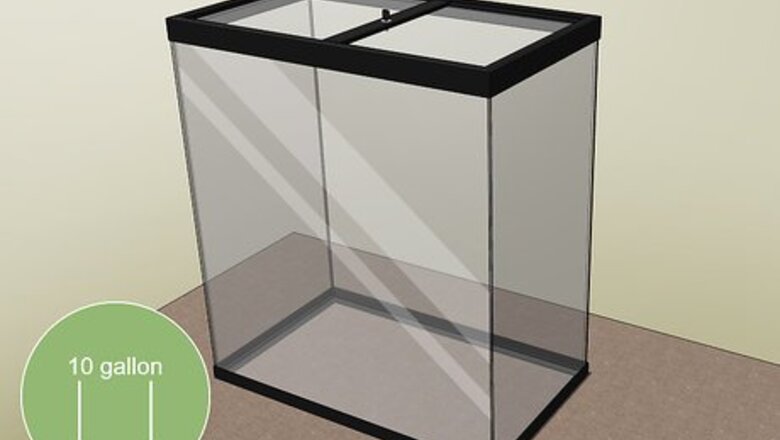
views
Creating the Right Environment

Use a tall 10 US gal (38 L) terrarium or tank to house your anole. The size of the container used will depend on whether you're keeping 1-2 anoles or a larger community of anoles. A 10 US gal (38 L) terrarium will provide enough space for 2 anoles; for larger communities, increase the volume of the tank by 5 gallons (19 L) for each additional lizard. For example, if you plan to house 5 anoles together, the size of the terrarium should be approximately 25 US gal (95 L). Always use a tank cover. Other pets (like cats) like to 'play' with anoles and this usually means death for an escaped anole.
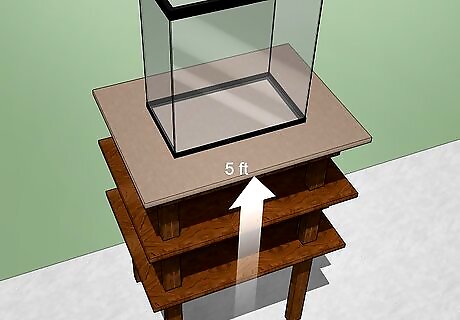
Keep your terrarium 5 feet (1.5 m) off the ground. Anoles in the wild tend to live an elevated lifestyle, dwelling in trees and other high places. Elevating your lizard tank is a good way to simulate this lifestyle for your lizard and help prevent them from becoming anxious. This is especially important if you plan to keep your lizard in a part of your home where there is a lot of activity and foot traffic. If the lizard is in an elevated spot, it will be less anxious about children and other animals constantly walking past its tank. You should also opt for a taller terrarium when purchasing your tank, as this will allow your lizard to climb even higher, which it will definitely enjoy doing. The best way to make sure your elevated tank is secure is to position it on a sturdy flat surface, such as a thick wooden table.

Line the bottom of the tank with 2 inches (5.1 cm) of soil, bark, or moss. Evenly fill the tank with around 2 inches (5.1 cm) of substrate; anoles aren’t burrowing lizards, so you don’t need the substrate to be too deep. Use untreated soil, bark, or moss substrate to make sure the terrarium environment is adequately humid for your lizard. If you use bark substrate, make sure it’s big enough that your anole can’t swallow it and inadvertently choke. The pieces of bark should be larger than the size of your anole’s head. Never use unsterilized bark or floor covering you're not sure about; ask the pet store or your vet for advice if you're unsure.
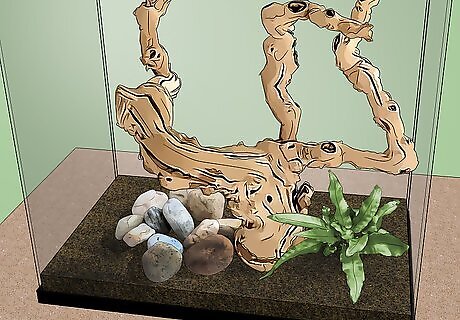
Place items in the tank that your lizard can climb or bask on. Inside the terrarium, be sure to supply plenty of plants (either real or artificial, or a mixture of both) and basking items such as branches or smooth rocks. Items that your lizard can climb on, such as vertically mounted pieces of driftwood or grapevine, would also be appropriate. If you’re keeping more than 1 anole in your terrarium, always provide many basking spots so as to avoid competition. For an ideal environment, provide at least 1 basking spot per lizard. If you’re only keeping 1-2 lizards, 1 basking spot will be sufficient. Be aware that unless it's breeding season, opposite-sex anoles may be very stressed if kept in a single container; talk to your vet if you have any concerns. Only add plants that aren’t harmful to reptiles to your anole tank. If you’re unsure if a plant will harm your green anole, check with your local veterinarian or pet store representative. A list of plants that can be harmful to reptiles can be found here: http://reptilesmagazine.com/list-of-plants-that-can-be-toxic-to-reptiles/ If you add real plants to the tank, make sure they haven’t been treated with pesticide. If you’re unsure about how clean they are, washing the plants thoroughly under running water should remove any harmful chemicals.
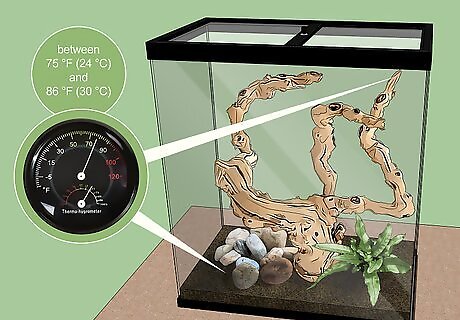
Keep the temperature in the tank between 75 °F (24 °C) and 86 °F (30 °C). Anoles need to be in a daily temperature range of approximately 75 to 86 °F (24 to 30 °C); any basking hot spots in your terrarium should be 90 to 95 °F (32 to 35 °C). The nighttime temperature can drop to 68 °F (20 °C) but no lower. Use 2 thermometers, 1 at the top of the tank and 1 at the bottom, to keep an eye on the temperature in your anole habitat. A fluorescent 40-watt bulb will create the right temperature during the day but must be turned off at night and replaced with a black light.
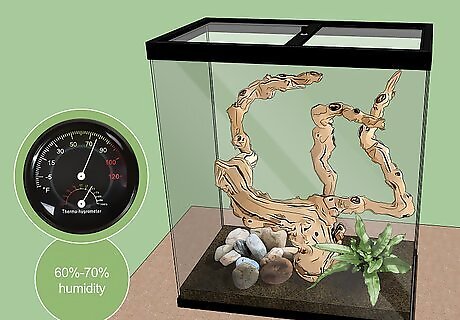
Maintain 60%-70% humidity in the terrarium. Green anoles are tropical lizards, so they’re used to a warm, wet climate. Spray mist on the substrate and on the plant leaves inside the terrarium to maintain adequate humidity in the tank and create a more tropical environment for your lizard. Attach a hygrometer to the side of the tank to keep a running measurement of the terrarium’s humidity. You can also use a drip system in the tank to achieve this level of humidity.

Keep your terrarium lit with UVB light for 14 hours each day. Anole lizards require continual exposure to ultraviolet B (UVB) lighting to synthesize vitamin D3 and to ensure their metabolism runs smoothly. Use a UVB to light your terrarium and keep it lit for 14 hours every day to keep your anole healthy. You can also expose your anole lizard to UVB light by temporarily placing its terrarium outside on sunny days when the temperature is over 70 °F (21 °C). Just make sure there is a secure screen on top of the tank so the lizard can’t get out and natural predators can’t get in! You can leave the terrarium in the sun as long as the temperature is high enough, provided there are shady spots in the tank.

Clean the terrarium every week to keep your lizards healthy. Reptiles in captivity are susceptible to health problems caused by germs and debris that build up over time in their containers. Thus, it’s very important to maintain and clean their home on a regular weekly basis. Use soap or dishwashing detergent to clean the inside of the tank, as well as any dishes or decor you’ve placed in the tank. Make sure you relocate your anole lizards to a separate, clean tank with a secure lid when you clean the primary terrarium. Unless the substrate looks particularly dirty or has a strong odor, it will only need to be changed once every 6 months. You can clean a portion of the substrate in between full cleanings. Never use any cleaning product containing phenol to clean your lizard’s cage, as reptiles tend not to tolerate this chemical very well. Any leftover, uneaten food should always be removed after mealtime to help keep the tank clean. To make tank cleaning easier, try putting a sheet of plastic down before you put in the substrate. This allows you to remove dirty substrate in 1 smooth step and prevents stains from accumulating on the bottom of the terrarium.
Feeding, Monitoring, and Handling Your Lizard
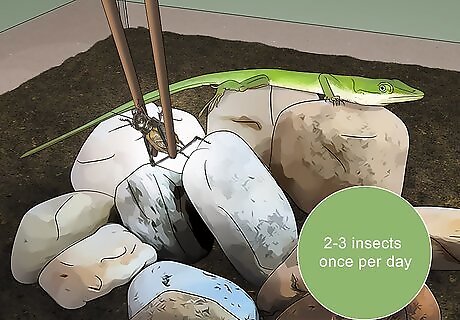
Feed your anole 2-3 insects once per day. Anole lizards are insectivores and tend to eat small insects such as crickets, mealworms, and wax worms. Provide 2-3 individual insects every day for each young lizard in your terrarium and 2-3 insects every other day for each adult lizard. To feed the anoles, simply place the live insects directly in the enclosure where your anoles can see them. When feeding your lizards worms, place the worms in a shallow saucer to prevent them from escaping or hiding from your lizards. Avoid feeding your lizard more insects than it can eat within 10-15 minutes. The anole must also have proper vitamins and calcium in its diet; since it eats feeder insects, all of the lizard’s extra nutrients must be contained in those insects. If you keep crickets around in bulk, "gut-load" them by feeding them a vitamin-rich cricket food prior to feeding them to your lizards. This way, all of the nutritious food your crickets just ate will then, in turn, be passed on to your anole. You can also dust the crickets with a supplement powder at each feeding to help ensure the anoles get enough calcium and vitamins. Avoid feeding your anole anything larger than half the size of its head. You should also not feed your lizard superworms or king-worms, as these possess powerful mandibles that might injure your anole. Anoles may also eat waxworms, fruit flies, small worms, canned crickets, small spiders, or earthworms. Occasional fast prey like small cockroaches or flies would also be welcome and would give your lizards some much-needed exercise.
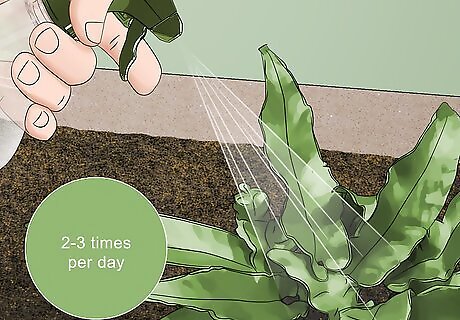
Provide water for your lizards by spraying plants in the tank 2-3 times a day. Anoles prefer to get their water in the form of droplets off plant leaves. To allow your lizards to drink water this way and to make sure they have adequate water, use a spray bottle to mist both the anoles and the plants in the terrarium for 10 seconds 2-3 times a day. If you choose to put a small water dish in the terrarium instead of misting the leaves, make sure it’s a shallow bowl. Anoles can drown by falling into a deep water bowl with steep sides. The water level in the bowl should never be any higher than the height of your lizard.
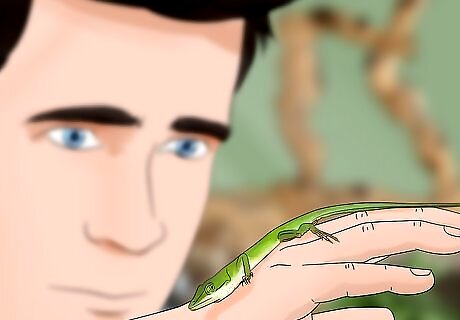
Monitor your anole for common health problems. The most common ailments that afflict anole lizards stem from overcrowding in their cages (leading to fights) and vitamin deficiencies. Keep an eye out for the symptoms of vitamin deficiency, such as lethargy, weight loss, or mucus in the mouth and nose, and feed your lizard a nutritious diet or vitamin supplements to minimize its risk of not getting enough vitamins. Other common symptoms of vitamin deficiency include swelling, bumps or sores on the skin, labored breathing, and limb paralysis. Contact your vet immediately if you start to notice these symptoms in your lizard. Note that the vet will need to be a specialist in exotic animals. Symptoms of fights breaking out between male anole lizards typically include small lesions and/or bite marks that appear on a lizard’s head or back. Some anoles will get infections on their snout along the mouth. This can be cleaned by gingerly and delicately wiping the snout with a cotton swab barely wetted in either hydrogen peroxide or an antibiotic ointment. Consult with your vet to figure out what would be a good reptile-suitable product. Leaving the anole’s terrarium too dirty can also heighten the risk of health concerns. Make sure you keep the tank clean every week, maintain it at a suitable humidity level, and get rid of any mold growth the second you see it. When you clean the tank, relocate your anole to a separate clean cage or tank for the time being.
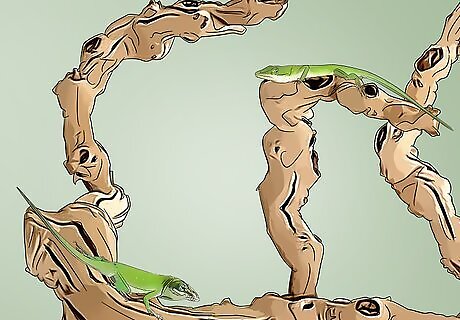
Consider adopting multiple anoles if you want them to breed. Although anoles can live by themselves, and it’s certainly easier to keep just 1 lizard at a time, you may want to adopt more than 1 anole so that they will breed (or just to have a more exciting terrarium environment). If you want to adopt multiple anoles and want them to breed, opt for 5 lizards altogether, with 4 females and 1 male. Beginning in late spring, a breeding female anole will lay a single egg every 2 weeks in a moisture-rich area. Feel free to leave the eggs in the terrarium, making sure that the area they’re in remains moist until they hatch (usually in 2 months). Note that if you want more than 1 male in your terrarium, you’ll need to have a tank big enough that they can easily avoid one another, as male anoles tend to be territorial and aggressive with other males. Newborn anoles require about twice as much food as adult lizards. Be sure to provide any hatchlings in your terrarium with lots of small live insects treated with vitamin supplements. Be aware that not everyone agrees that anoles are sociable enough to live in a close vivarium or tank community where they can't get away from each other. Some people believe that anoles should be kept separate from one another in different tanks or containers. This type of setup is more comfortable for the individuals inhabiting the tanks, and not as unnatural; therefore, it is less stressful and more healthy for the anoles.
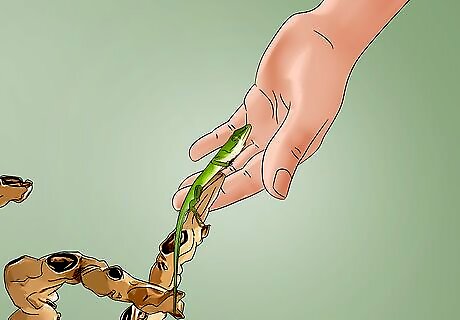
Handle your anole rarely and with caution. It is possible to handle an anole and even have it eat from your hand. The anole may learn to sit on your hand in exchange for a treat but don't put the anole there. Instead, allow it to crawl onto your hand of its own volition, as this is much less stressful for it. Also, bear in mind that anoles move very fast and are very agile, so don't handle it anywhere it might escape from. On the whole though, an anole is much more of a pet for watching than for holding, so keep handling to a minimum. If you need to move an anole (and this may be for feeding and cleaning purposes at the very least), be very gentle. Grip firmly but very gently and move him without delay. Always wash your hands after handling the green anole, as with any reptile or pet. In addition, wash your hands after handling any bedding or tank decorations to prevent the spread of salmonella. Your anole might lightly bite you when you hold it. Don’t be afraid! This will be a very light bite and shouldn’t be painful at all. Try not to overreact and jerk your hand back if your anole bites you, as this might inadvertently hurt your lizard’s jaw.


















Comments
0 comment